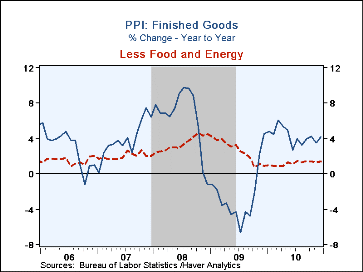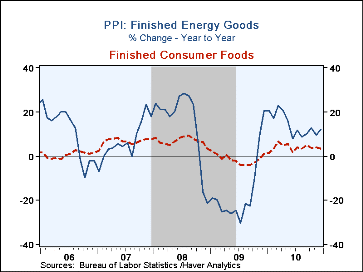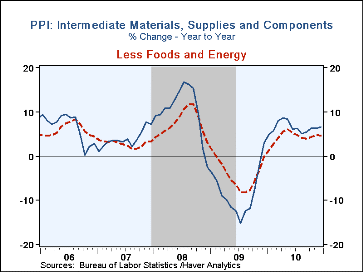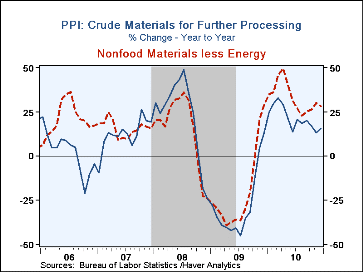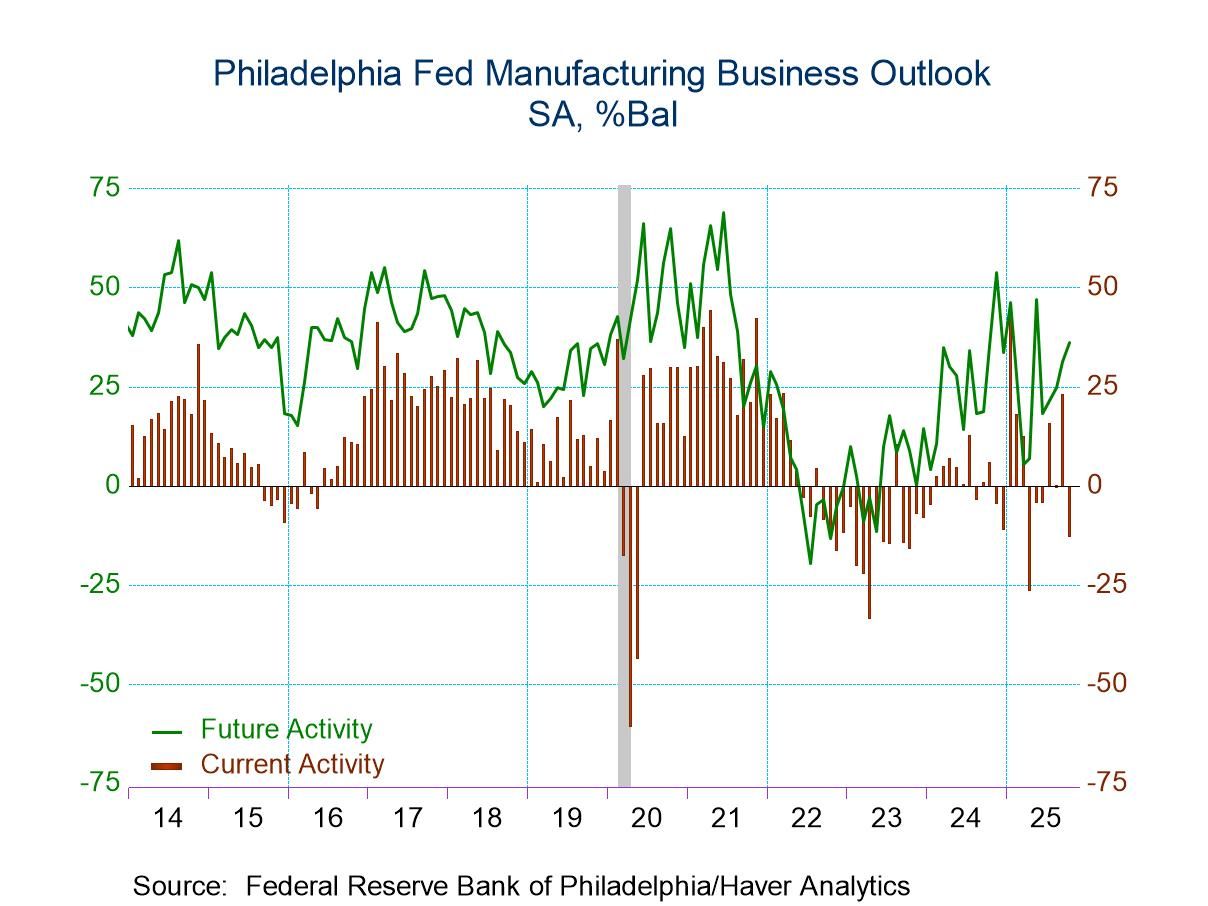 Global| Jan 13 2011
Global| Jan 13 2011U.S. PPI Posts Strongest Gain Since 2008
by:Tom Moeller
|in:Economy in Brief
Summary
The U.S. Producer Price Index for finished goods jumped another 1.1% last month after its 0.8% November surge. The rise outpaced Consensus expectations for a 0.8% increase and it pulled the overall gain in prices last year to 4.3%, [...]
The U.S. Producer Price Index for finished goods jumped another 1.1% last month after its 0.8% November surge. The rise outpaced Consensus expectations for a 0.8% increase and it pulled the overall gain in prices last year to 4.3%, the highest since 2008. Higher energy prices continued as the driving force behind the strength while food prices also remained firm. The PPI less food & energy rose a moderate 0.2% after a 0.3% November increase. The gain matched Consensus expectations.
Energy prices led last month's pricing strength with a 3.7% jump (12.3% y/y) as gasoline prices increased 6.4% (18.4% y/y). Since the late-2008 low, gasoline prices have roughly doubled. Home heating oil prices also were strong, posting a 12.3% increase (27.8% y/y). Natural gas prices rose a moderate 0.9% (-1.1% y/y) and electricity prices rose 0.7% (3.8% y/y). Food prices continued strong. The 0.8% increase (3.5% y/y) reflected strength in beef & veal (15.1% y/y), fish (12.7% y/y) and fresh fruit & vegetable (3.9% y/y) prices.
Core finished consumer goods prices rose a moderate 0.2% (1.4% y/y). For the full year the 1.2% increase was the weakest since 2003. Furniture prices rose 1.3% since last December while passenger car prices fell 2.1%. Capital goods prices inched up 0.1% (0.4% y/y).
Intermediate goods prices jumped another 1.0% as energy prices surged another 3.1% (13.8% y/y). That increase was accompanied by a 0.6% gain in food prices (6.2% y/y). Core-intermediate prices remained firm with a 0.4% gain (4.5% y/y). Earlier strength in crude goods pricing continued with a 4.0% gain due to a 7.7% jump in energy prices. Energy prices rose 6.2% Dec/Dec but 22.4% for the full year. Crude food prices rose 18.8% y/y. Continuing to reflect strength in the industrial sector, core crude prices posted another 3.1% (28.1% y/y) jump that was led by higher iron & steel scrap (39.5% y/y), aluminum base scrap (20.9% y/y) and copper scrap (22.8% y/y) prices.
The PPI data are contained in Haver's USECON database with further detail in PPI and PPIR.
Economic Outlook Symposium: Summary of 2010 Results and Forecasts for 2011 from the Federal Reserve Bank of Chicago can be found here.
| Producer Price Index (%) | Dec | Nov | Oct | Year Ago |
2010 | 2009 | 2008 |
|---|---|---|---|---|---|---|---|
| Finished Goods | 1.1 | 0.8 | 0.4 | 4.1 | 4.3 | -2.5 | 6.4 |
| Energy | 3.7 | 2.1 | 3.7 | 12.3 | 14.0 | -17.6 | 14.1 |
| Food | 0.8 | 1.0 | -0.1 | 3.5 | 4.0 | -1.4 | 6.8 |
| Less Food & Energy | 0.2 | 0.3 | -0.6 | 1.4 | 1.2 | 2.6 | 3.4 |
| Intermediate Goods | 1.0 | 1.1 | 1.2 | 6.6 | 6.5 | -8.4 | 10.3 |
| Less Food & Energy | 0.4 | 0.7 | 0.6 | 4.5 | 4.3 | -4.2 | 7.4 |
| Crude Materials | 4.0 | 0.6 | 4.3 | 15.6 | 21,1 | -30.3 | 21.4 |
| Less Food & Energy | 3.1 | 3.1 | 2.1 | 28.1 | 32.6 | -23.5 | 14.8 |
Tom Moeller
AuthorMore in Author Profile »Prior to joining Haver Analytics in 2000, Mr. Moeller worked as the Economist at Chancellor Capital Management from 1985 to 1999. There, he developed comprehensive economic forecasts and interpreted economic data for equity and fixed income portfolio managers. Also at Chancellor, Mr. Moeller worked as an equity analyst and was responsible for researching and rating companies in the economically sensitive automobile and housing industries for investment in Chancellor’s equity portfolio. Prior to joining Chancellor, Mr. Moeller was an Economist at Citibank from 1979 to 1984. He also analyzed pricing behavior in the metals industry for the Council on Wage and Price Stability in Washington, D.C. In 1999, Mr. Moeller received the award for most accurate forecast from the Forecasters' Club of New York. From 1990 to 1992 he was President of the New York Association for Business Economists. Mr. Moeller earned an M.B.A. in Finance from Fordham University, where he graduated in 1987. He holds a Bachelor of Arts in Economics from George Washington University.


